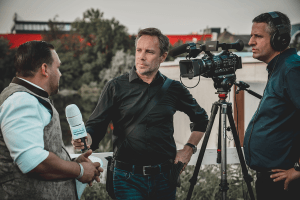Closing the Gap — Understanding Media Relations
Published on November 8, 2019, at 2:45 p.m.
by Ally Denton.
Public relations professionals are no strangers to the media. We are constantly keeping up with news and trends — ensuring we are at the cusp of anything newsworthy. In this field it’s common to interact with media gatekeepers, and with collaboration comes communication.
Taking a look at the media relations industry from an insider’s point of view can strengthen PR professionals’ knowledge and lead to better partnerships. Public relations and media relations go hand in hand, but the lines can get blurry, especially with new communication channels appearing daily.
According to Everything-PR, media relations consists of a company’s interaction with the media and its key players — editors, reporters and journalists.
Blast Media noted that a PR practitioner’s goal is to shape and communicate their client’s newsworthy message to their audience. According to Blast Media, media relations provides the megaphone for sharing this message by utilizing one of the most trusted, cost-effective methods.
In order for PR professionals to achieve their goals, it’s imperative to understand another one of their main audiences — media relations experts — and to implement simple lessons to close the gap.

Understanding media relations
A disparity between the two groups is the fact that many people in PR have never worked as journalists or reporters and don’t completely grasp what their day-to-day looks like.
WBRC FOX6 News’ News Director Shannon Isbell described her daily duties as management-focused: “I am the leader of the news department, but I have a team of seven other managers that help me manage each daypart.” Isbell said she spends her day “culling through emails, managing the Investigative Team, HR issues, legal concerns, meeting with upper leadership, as well as other departments to talk about special projects, planning, budgets and revenue, etc.”
Isbell continued, “People think it’s glitz and glamour, especially if you’re on TV. The truth is reporters’ work is really, really hard.”
Although it isn’t always glamorous, Isbell noted that “journalists are the documenters of history. That affords us better seats to events than money can buy.” Acknowledging the journalists’ role is essential for PR pros as they reach out to journalists and reporters to cover their stories, Isbell added, “[Our position] allows us to tell stories about the communities we serve and effect change.”

Pitching effectively
Public relations specialists are certainly familiar with press releases, but making sure to pitch them effectively isn’t always as easy as it seems.
In a webinar, freelance journalist Oliver Gee observed that when PR pros send out rubbish mass emails, it ruins the chances for other people who have something good to say from being heard.
Isbell agreed, advising PR professionals to “make your pitch stand out and make it succinct!”
Tailoring your pitch is a crucial element is getting the story picked up. A targeted approach ensures you’re reaching the right person, at the right time, with something that’s relevant to them and their audiences.
In the Cision State of the Media 2017 survey, journalists said their biggest motivator for pursuing a story is when someone shows knowledge of their previous work.
Isbell suggested making sure journalists’ questions — such as “What is visual about the story? Why should we cover it? What impact will it have on our viewers? — will be answered. Do your research and include a comprehensive pitch to spark their interest.
Utilizing established media outlets
Gaining media coverage is a great way to tap into different audiences, and most media outlets have spent years building their reach. They have more status and authority than social media, so traditional media coverage will help your newsworthy story gain credibility (CP Communications).

Gray Television is a leading player in the communication and broadcasting field. Ellenann Yelverton, vice president and deputy general counsel for Gray Television, said, “Gray currently owns and/or provides services to television stations and digital properties in 93 television markets, covering approximately 24 percent of U.S. television households and broadcasting over 400 separate programming streams.”
Reaching these established audiences could be extremely beneficial for PR professionals and their respective clients, but it isn’t always easy. There are many challenges on the media relations side that PR practitioners aren’t aware of.
Isbell explained, “The president has declared war on the media. That’s just a fact. It isn’t a political statement. This [situation] leads to many complications with covering stories and gaining the information necessary for such.”
Yelverton, speaking from a legal standpoint, noted, “We have pre-publication duties we can do to help to try to make sure the reporters and news stations have what they need to properly document news.” She added that many pre- and post-publications’ issues are top-of-mind and urgent, typically from a news station viewpoint, and require constant, quick answers from the news-review legal teams.
Public relations and media relations can run into similar legal issues where access and speech are concerned. Learning the ins and outs of the process encourages favorable partnerships amongst all three facets of communications.
Taking all of these tips and insider tidbits into account can form a holistic view of the media relations field and its role in disseminating information to the public. As PR professionals, it is vital to effectively communicate — especially to our fellow media gatekeepers.




